12
Diversity And Conservation
The importance of insects in the world’s ecosystems cannot be overstated—we and all other vertebrates are heavily dependent on them. Millions of different insect species exist, each with its own role in the environment, but today insects are dying out at an alarming rate, and active conservation has never been more vital.
12.2 • Insect communities in different habitats
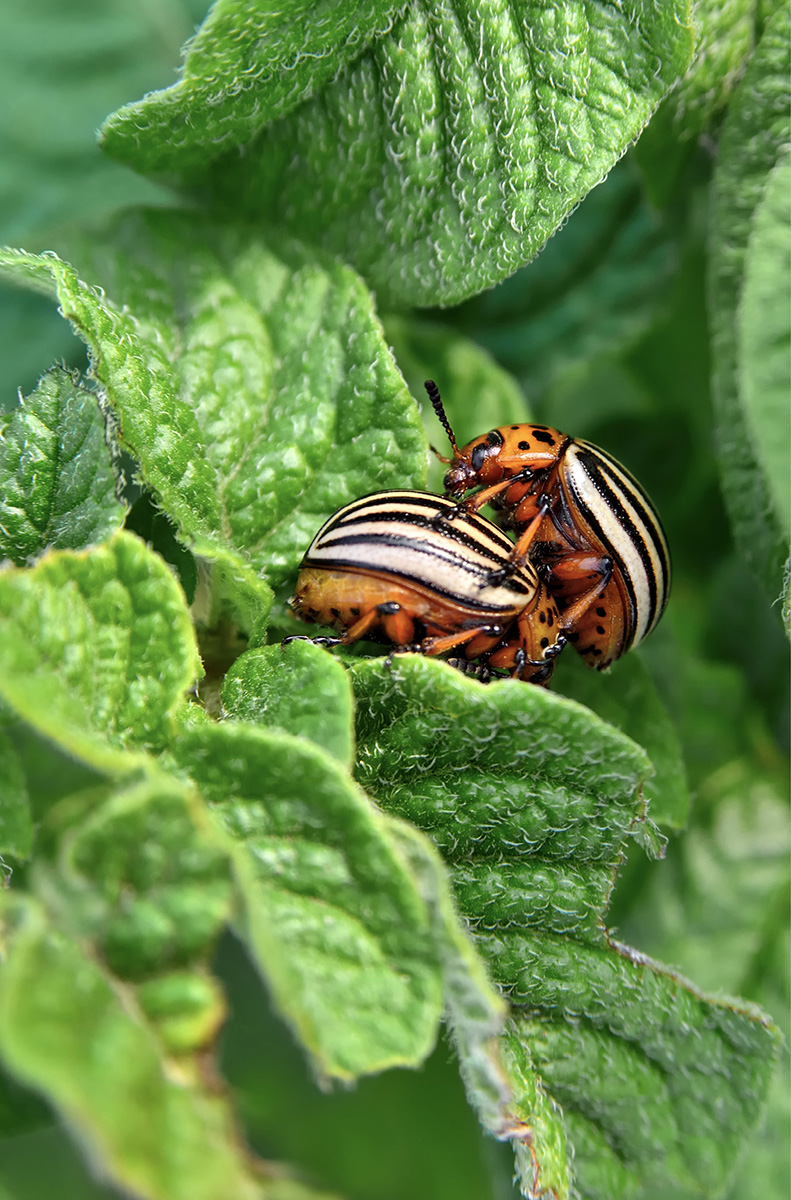
The Colorado Potato Beetle, native to parts of North America but accidentally introduced to many other areas, is the world’s most significant insect pest of potato crops.
types of insects
All of the insects on Earth belong to one of 30 or so main groupings, or orders. Some of these orders are very familiar to us, and contain many thousands of species.
There are four insect orders that dominate the rest in terms of species diversity, with at least 100,000 species each. They are the beetles (Coleoptera), the true or two-winged flies (Diptera), the wasps, bees, ants, and sawflies (Hymenoptera), and the butterflies and moths (Lepidoptera). All of these four are holometabolous (going through complete metamorphosis) and they can be found in all continents except Antarctica.
Other sizable insect orders include the true bugs (Hemiptera) with about 75,000 described species worldwide. This order is the most diverse of all of the hemimetabolous (partially metamorphosing) insects, and also the most diverse, with great variation in body-shape and lifestyle. Behind the true bugs come the grasshoppers, crickets, katydids, and relatives (Orthoptera) with nearly 20,000 species, and the caddisflies (Trichoptera), with some 14,500 known species. Other well-known insect orders include the cockroaches and termites (Blattodea; about 7,400 species), the dragonflies and damselflies (Odonata; about 5,500 species), the lacewings and their relatives (Neuroptera; some 4,000 species), the stoneflies (Plecoptera; about 3,500 species), the stick insects and their relatives (Phasmatodea; about 2,500 species), the mantises (Mantodea; about 2,300 species), and the earwigs (Dermaptera; about 1,000 species).
Examples of all of these orders can usually be found quite easily in most parts of the world, though less so the farther you depart from large landmasses in tropical areas. Each group has its own distinctive traits and, despite the vast number of species, it is usually relatively straightforward to work out which is the right order for any unknown insect you encounter.

A barklouse is one of the members of the little-studied order Psocoptera.
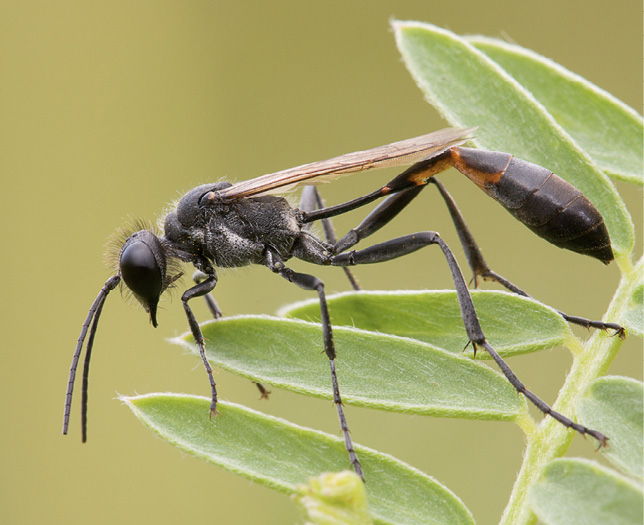
The highly diverse order Hymenoptera includes some impressive predators, such as the elegant Ammophila hunting wasps.
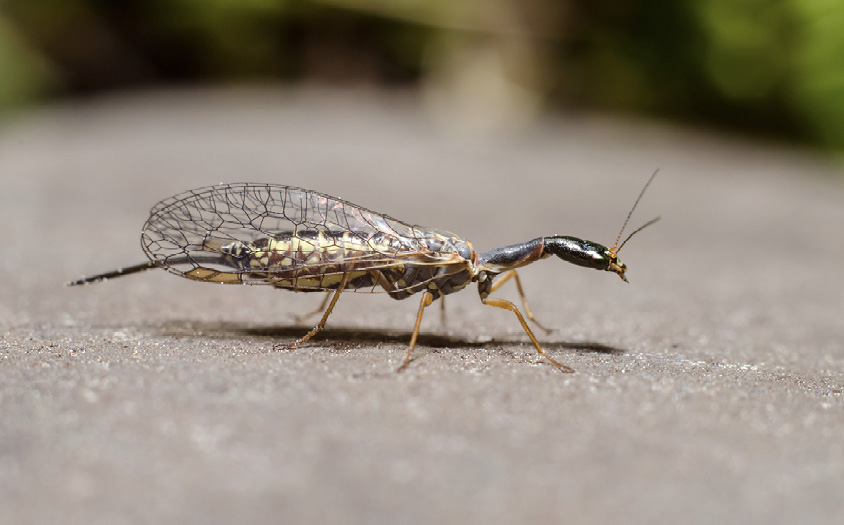
The snakeflies, belonging to the order Raphidioptera, are distinctive, large-winged insects with elongated thoraxes.
obscure orders
The remaining insect orders are much less known by casual and amateur nature-watchers, because they are fewer in number and more difficult to observe. Among them are the web spinners (Embioptera), about 200 species of mostly tropical, four-winged insects that live in the soil or other substrate, inside webs and tunnels spun from silk, which they produce from glands in their front legs. The extremely tiny insects that form the order Strepsiptera resemble true flies in that they have only one pair of functional wings, the other being reduced to small clubs (halteres). All 600 or so species are parasites of other insects. The 1,000 or so booklice and barklice (Psocoptera) are small, primitive insects with grinding jaws. Booklice are wingless and mainly live inside human dwellings, where they can damage stored foods and other organic material (including the pages of books). The biting and sucking lice (order Phthiraptera) are wingless, strong-legged parasites of birds and mammals—the biting lice chew on skin, hair, or feathers, while the sucking lice suck blood or other bodily fluids.
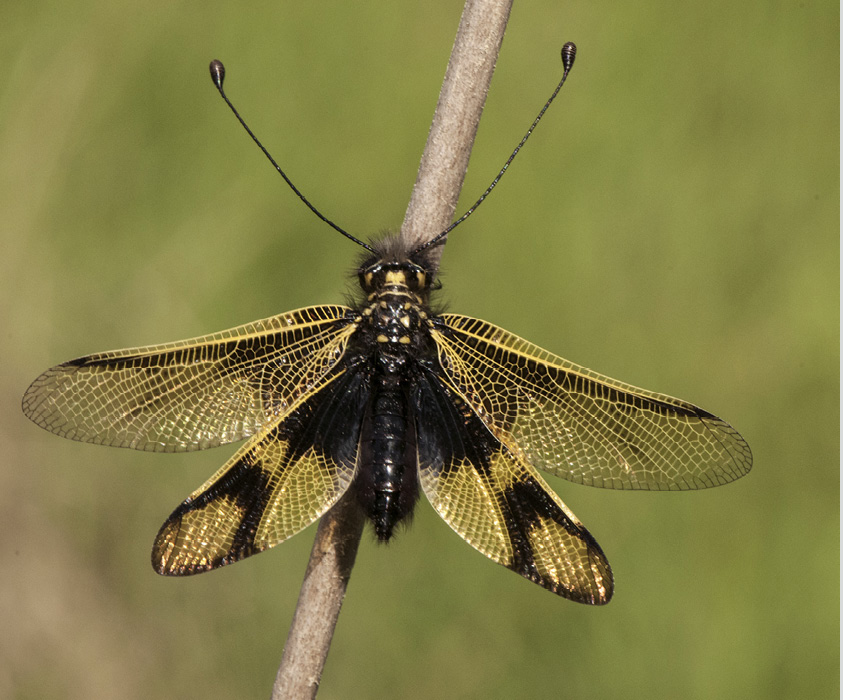
The order Neuroptera includes several very striking families, including the predatory, rather dragonfly-like owlflies (family Ascalaphidae).
DOMESTICATED INSECTS
Relatively few wild animal species have been kept in captivity long enough and in large enough numbers to be classed as fully domesticated, but among them are some very economically important insects.
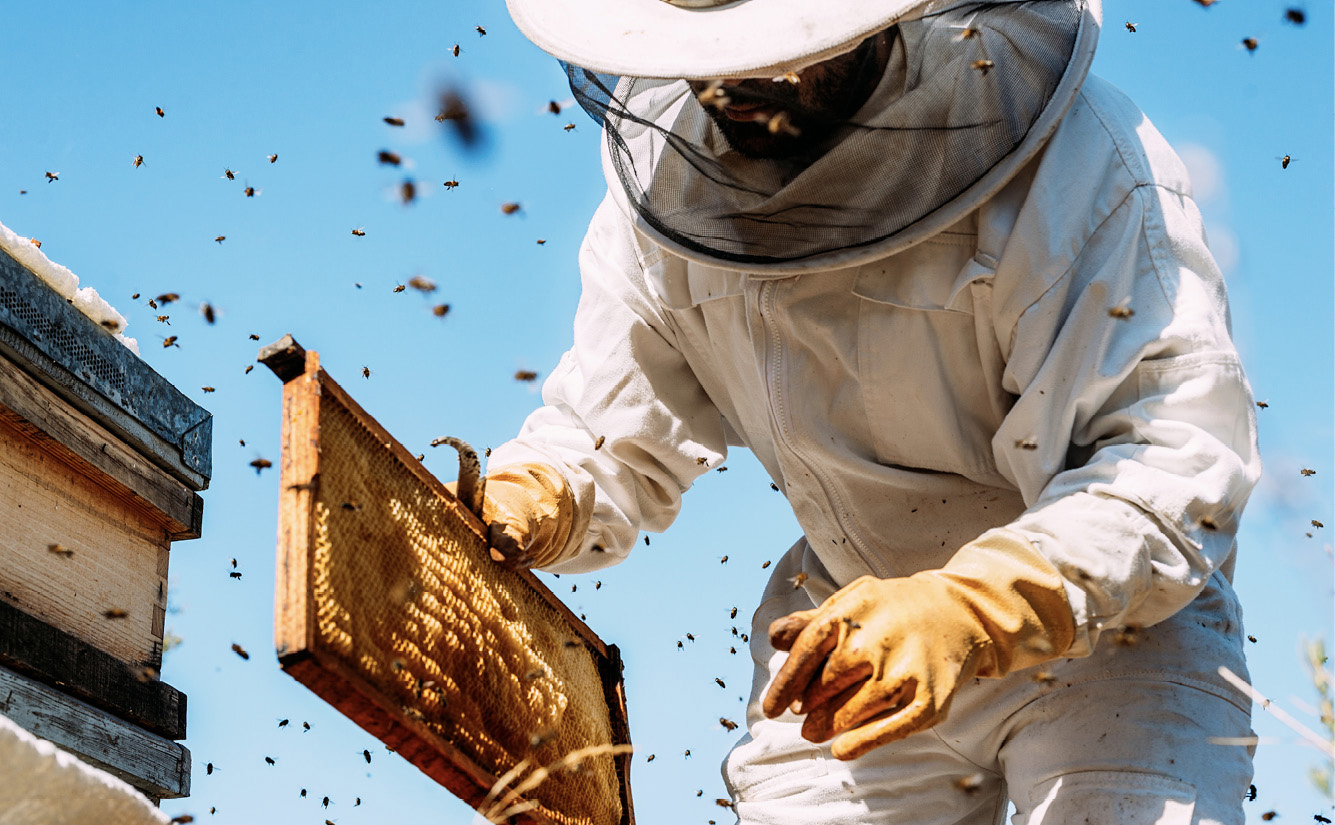
A single hive of honeybees can produce 60 pounds (27kg) of honey over a season.
The best-known domesticated insect is the European or Western Honeybee (Apis mellifera). It is one of several social bee species that produces honey in its large nests, and humans have a long history of exploiting it and its relatives in the wild. The invention of beehives and an understanding of how to control and manage the bee’s natural behavior led to its domestication, with the first evidence of deliberate beekeeping coming from North Africa (where the species naturally originated) some 9,000 years ago. Today, honeybees are used not only to produce honey and other products like beeswax and royal jelly, but as crop pollinators—hives are moved around as needed to ensure the bees pollinate the target plants. The total commercial value of honeybees worldwide is around $200 billion per year.
The Silk Moth (Bombyx mori) is the domesticated form of the wild species B. mandarina. It is a large moth, originating from Japan, China, and Korea, and is kept for the cocoons its larvae spin around their pupae. The threads they secrete from their mouth glands are used to weave silk, which developed into a lucrative trade. Each cocoon may yield a mile of thread, but because the moth damages the threads when it emerges, commercial silk-farming involves killing the pupae before this occurs, except for a small number from which the adult moths are used for breeding.
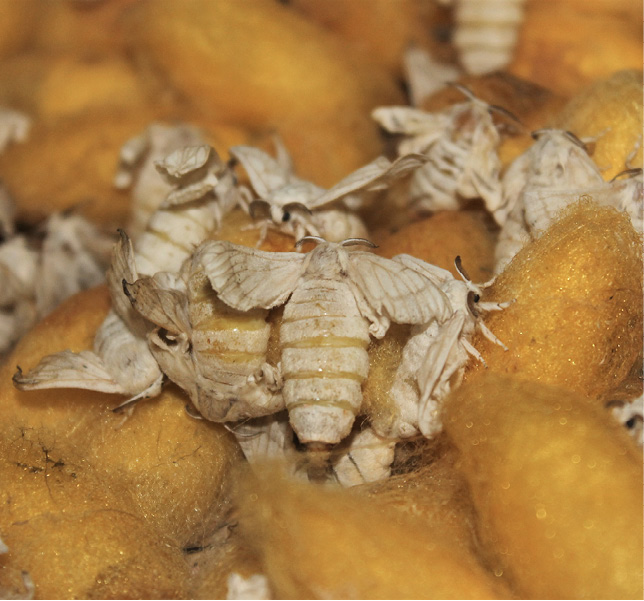
The domesticated Silk Moth has long since lost the ability to fly.
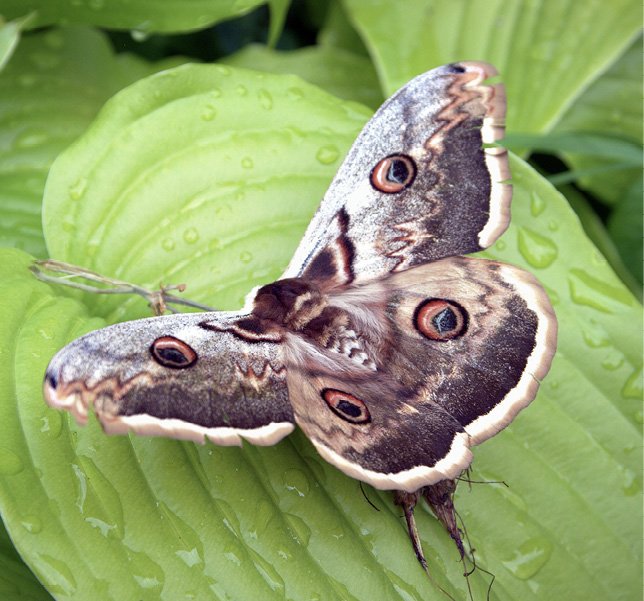
The Silk Moth’s wild relatives include the spectacular Giant Peacock Moth (Saturnia pyri).
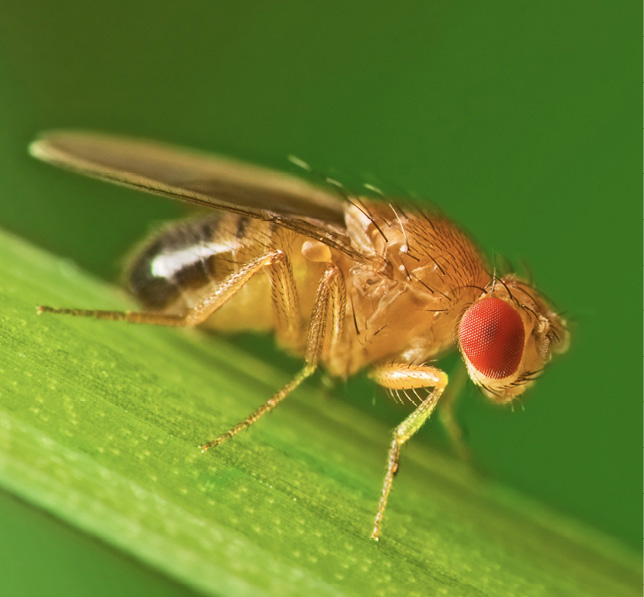
Much of what we know today about animal genetics comes from research on the Common Fruit Fly (Drosophila melanogaster).
Like many domesticated animals, Silk Moths are quite different from their wild ancestors. Their wings have reduced in size and have lost their natural camouflaging pigments. They will also feed on other foods besides mulberry leaves (the sole food plant of the wild species). Deliberate selective breeding produced these traits, which make the moths easier to keep in captivity. Research is underway to modify the Silk Moth genome in such a way that, instead of silk, their caterpillars secrete different proteins, with other commercial or medical uses.
Model organisms
Another domesticated insect is the Common Fruit Fly (Drosophila melanogaster), famous for its use in genetic research. The fly is ideal for this purpose as it is very easy to breed in the lab and has a relatively simple genome. Mutated forms have been developed with undersized or twisted wings, and different eye and body colors, and each mutation’s position in the genome has been documented.
The Black Soldier Fly (Hermetia illucens) is beginning to be used commercially as a food source for pet cats and dogs. Its larvae are protein-rich and may be kept easily at high densities in small spaces. They feed on decaying matter, so can be sustained on waste food of all kinds.
insect communities in different habitats
Wherever a variety of plants grow, there will be plenty of insects, but it is the nature of the plant community that will dictate which kinds of insects are most numerous.
Different ways to classify habitat types, or biomes, have been used by different groups over the last few decades. Today, the WWF, or World Wide Fund for Nature, recognizes 14 types of terrestrial (land) biomes, and 12 freshwater biomes. The criteria for definition for the land biomes are, broadly speaking, types of plant cover (forest, woodland, grassland, shrubland, or desert), humidity, altitude, and latitude (tropical, subtropical, temperate, or polar), while the freshwater biomes also take into account the water flow (river or lake). To these types could also be added a range of anthropogenic biomes—habitats that have been extensively modified by humans, primarily urban areas, tree plantations, and croplands.
Natural woodland and forest support the greatest range of insect species. Leaf litter provides foraging and hiding places for ground beetles and ants, herbaceous understory plants support plant-sucking true bugs, and their flowers sustain butterflies, bees, and hoverflies. Tree trunks are full of fissures in which insects can hibernate, decaying wood is food for beetle larvae, and the foliage of different tree species supports a great range of insects, including aphids, moth caterpillars, and bush crickets. An abundance of plant-eaters attracts predators. A tree plantation may look just as lush as a natural forest but supports far fewer species of animals, as it typically contains only one species of tree, and usually has no understory and no decaying wood to speak of.
Grassland is less species-rich than forest, but scrubby grassland in particular can include large numbers of flowering plants, and thus is very attractive to far-ranging nectar-feeders such as larger butterflies, moths, and bees. Where grassland is close to water, it is also often home to maturing newly emerged dragonflies and damselflies.
Freshwater habitats are home to certain insect groups that lay their eggs in water—among them dragonflies and damselflies, caddisflies, stoneflies, alderflies, and mayflies. Different species have different preferences—some favor cold upland streams, others slow-flowing, well-vegetated lowland rivers. Some water-dependent species are adapted to breed rapidly and make use of temporary, seasonal pools and puddles.
insects in gardens
Gardens vary individually, but in general are similar to light woodlands in their vegetation community, with trees, shrubs, and clearings. However, many gardens are kept much “tidier” than natural habitats, with little ground cover, and their flora includes many non-native species, which will support few, if any, native herbivorous insects. The widespread use of chemical pesticides can dramatically reduce insect populations.

Many insects spend their larval stages underwater, while others feed on plants that grow in freshwater habitats. Wetland species include the Common Picturewing dragonfly.

Flower-rich meadows support many nectar-feeding insects, which in Eurasia and North Africa may include the Marmalade Hoverfly.

The Southeast Asian planthopper Pyrops candelaria is one of many striking insects found in tropical forest habitats.
INSECTS IN EXTREME CONDITIONS
Habitats with warm temperatures and an abundance of food sources support the widest variety of insect species, but a few are adapted to live in much more challenging conditions.
Optimal habitats may meet all of an insect’s needs, but they have one significant disadvantage—competition. The consequences of competition are that species tend to become more highly specialized, and that makes them vulnerable. A moth that only lays its eggs on one species of plant may be exquisitely adapted to exploit that host plant, but it will not survive if the host plant dies out.
The Arctic Wooly Bear Moth (Gynaephora groenlandica) lives in Greenland and Arctic Canada. The caterpillar, like those of other tiger moth caterpillars, has long hair on its body. Completely inactive for most of the year, it can endure temperatures as low as –94°F (–70°C) within its silk-lined shelter or hibernaculum, thanks to chemicals in its cells that protect them from damage when they freeze. On the warmest days, it basks in sunshine to absorb heat, which speeds up its metabolism. Once mature, it pupates, emerges, and breeds over just four weeks, in the height of the Arctic summer. Larvae of the Antarctic Midge (Belgica antarctica) survive freezing by becoming dehydrated, preventing the formation of damaging ice crystals.
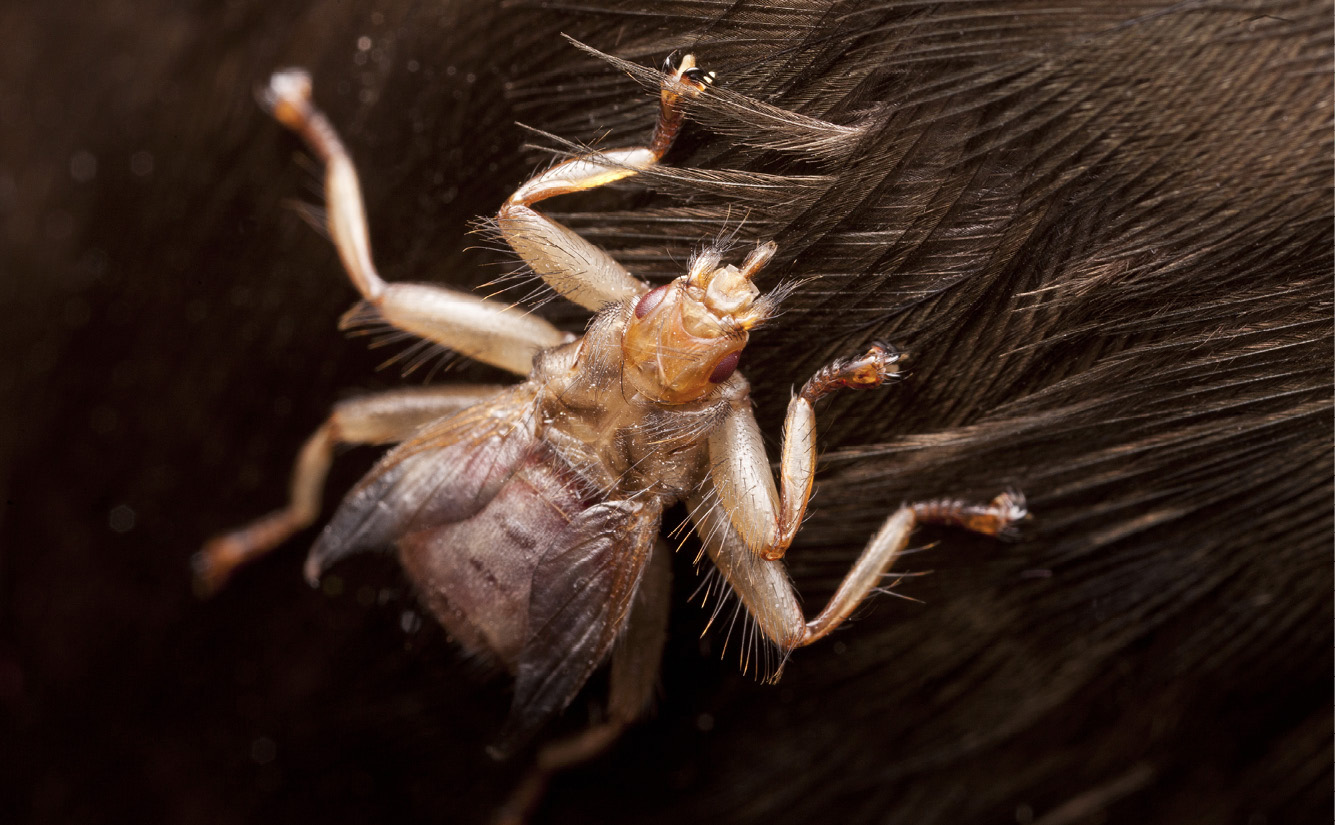
Louse flies spend much of their lives clinging to the feathers of fast-flying birds such as swifts.
Living on the bodies of other animals presents a particular set of challenges, especially when the host animal is a small, fast-flying bird that is also a long-distance migrant. The Swift Lousefly (Crataerina pallida) lives on the blood of swifts, and its larvae overwinter in swift nests after the birds set off on migration. Although the louse is a large insect, its very flattened body means that it can slide under the bird’s feathers and thus remain attached while the bird is airborne (on flights that may last days and involve speeds of up to 68 miles per hour/110kmh).
Desert baskers
Several African beetles of the family Tenebrionidae are adapted to survive in the Namib Desert. This hot, dry environment encourages rapid dehydration, but these beetles have physical adaptations to minimize water loss. A couple of species have also evolved ingenious ways of obtaining water from the early morning mists that sweep the dunes. The most famous is the Head-stander Beetle (Onymacris unguicularis). These beetles climb to the summit of a dune before dusk and stand on their front legs, hoisting their rear ends into the air. Fog condenses on their backs and runs down to their mouthparts. They are capable of consuming large volumes of water—up to 40 percent of their own body-weight.
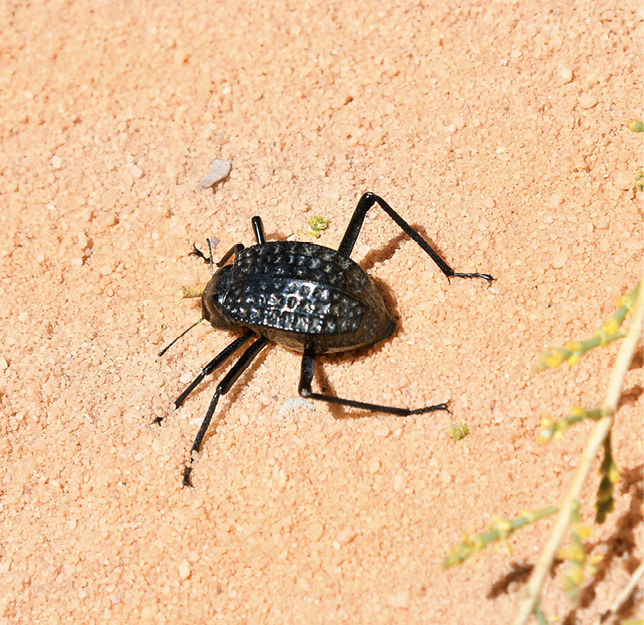
Some desert-dwelling tenebrionid beetles have bumps on their elytra, where fog will condense.

A Head-Stander Beetle in the Namib Desert: This species performs early morning handstands on its front legs to encourage fog to condense on its back.
THE ECOLOGICAL ROLES OCCUPIED BY INSECTS
As the most abundant group of land animals on Earth, in terms of diversity of species, insects play many vital roles within ecosystems in all kinds of habitats.

This pyramid diagram, though simplified, indicates how energy from sunlight passes from plant to herbivore to carnivore. With each stage, some of the energy is lost—therefore, the biomass of lower-tier organisms in any environment will always be much higher than that of higher-tier organisms.
All life needs energy, and animals obtain theirs through eating other animals and plants. This energy’s original source is our Sun. Through photosynthesis, green plants and bacteria-like microorganisms called cyanobacteria can use sunlight to drive a chemical reaction in their cells that turns water vapor and carbon dioxide into glucose—a simple sugar that is the basic energy supply for living things. Photosynthesis enabled plant-eating animals to evolve, and therefore animal-eating animals, too.
Ecosystems are built upon “producers,” which photosynthesize. On top of that layer are the “consumers,” which obtain their energy by eating the producers. There is then an opportunity for another tier of consumers—the predators, which eat the first-tier consumers. The producers must greatly outnumber the consumers for the system to remain stable, which is why ecosystems on tiny isolated islands can be so vulnerable to destructive one-off events. But in a stable ecosystem, there are opportunities for species to become more specialized, and for biodiversity to increase as evolution progresses. The result is not a neatly tiered cake but a complex web of life, incorporating not just herbivores and carnivores but also omnivores, parasites, scavengers, and more.
Niches
The ecological position an animal occupies—where it lives and what it consumes—is termed its niche. For example, a diving beetle is a predator of small animals in freshwater habitats. A dragonfly larva has a similar niche, but the adult dragonfly occupies a different niche, being an aerial predator of other flying insects. Niches can overlap, but where the extent of overlap is considerable, competition between the niche-holders exerts evolutionary pressure toward more extreme specializations.
Insects occupy all kinds of ecological niches. Some species are particularly influential and important within their ecosystems—without these so-called keystone species, the ecosystems would be drastically different. Insect keystone species include termites, which create islands of soil fertile enough to support miniature forests in savannas, and aphids, which excrete honeydew on tree foliage that sustains myriad other insects, especially when nectar is in short supply. Insects such as blowflies and burying beetles are also vital disposers of carrion and animal droppings.
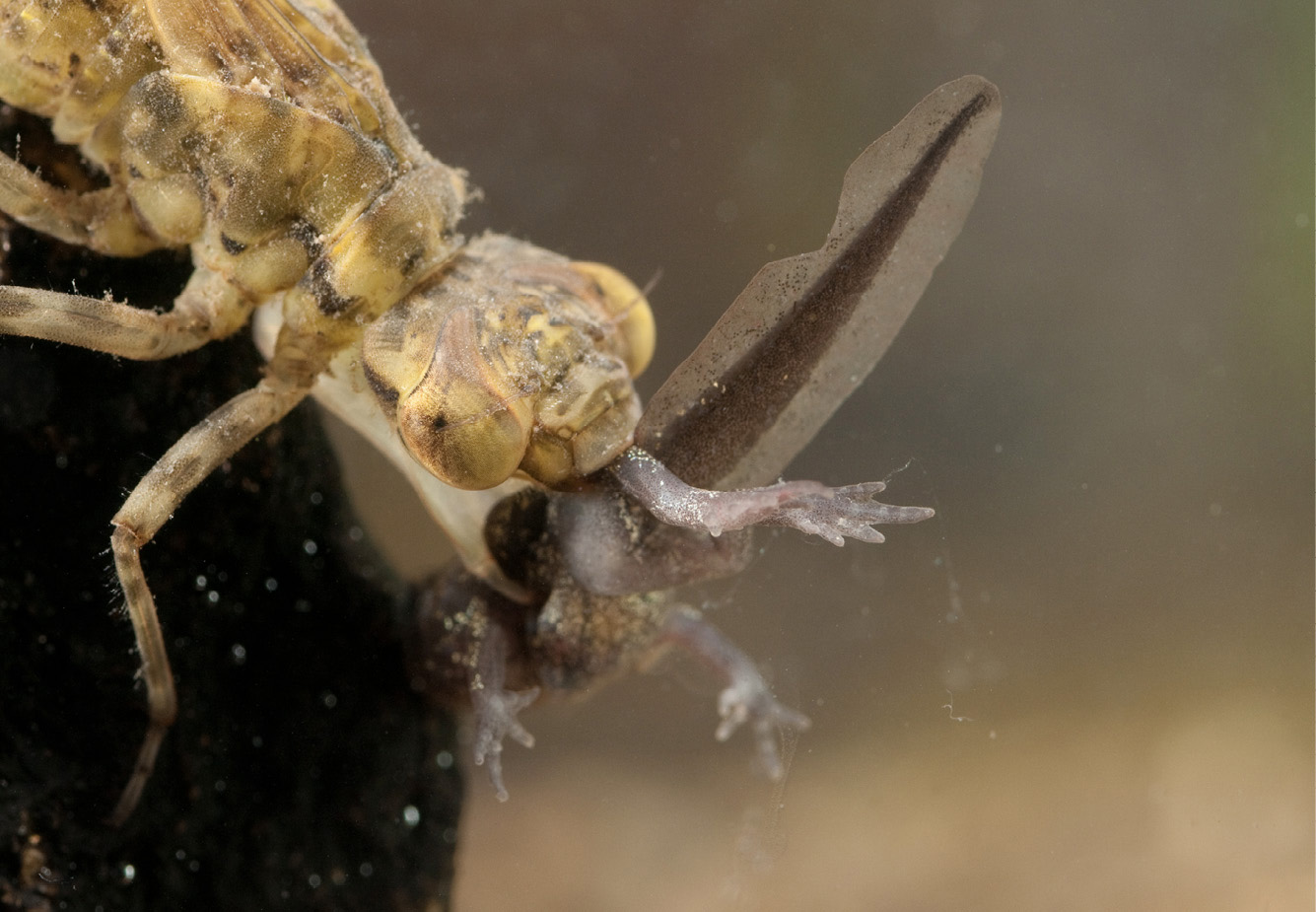
This is a rare example of an insect hunting a vertebrate: a dragonfly larva captures a tadpole.
INSECTS AS BIOCONTROL AGENTS
When one species causes problems for us, we have sometimes attempted to solve it by introducing another species to control the first. This method can be effective, but can also go horribly wrong.
Humankind’s early attempts to practice biocontrol (using one living thing to reduce the population of another) have resulted in some significant ecological problems. In New Zealand, people introduced stoats to prey on the large numbers of previously introduced rabbits, reasoning that, because stoats are effective predators of rabbits in Europe, the same would apply in New Zealand. The result, though, was that the stoats preferred to hunt native New Zealand birds, which, having never encountered stoats in their evolutionary history, were entirely ill-equipped to cope with the new danger. Now, both stoats and rabbits are problematic invasive species in New Zealand.
The important lesson to learn from this and similar case histories is that biocontrol is highly risky unless the controlling agent is adapted to attack only one target species. This is where insects are perceived as reliable agents—specifically, the parasitoid wasps and flies that lay their eggs on or in the bodies of just one host species.
Today, several parasitoids have been used successfully to control particular problematic insects. In French Polynesia, the non-native Glassy-Winged Sharpshooter (Homalodisca vitripennis), a large plant-eating leafhopper, has been reduced in number by 95 percent by the wasp Gonatocerus ashmeadi. The parasitoid wasp Encarsia formosa was used as a controlling agent for the Glasshouse Whitefly (Trialeurodes vaporariorum) in commercial greenhouses from the 1920s, and although its use was reduced dramatically when pesticides became widely available from the mid-20th century, it is now enjoying a considerable revival as many growers seek to reduce pesticide use. Biocontrol agents like these can be used by certified organic farmers and growers, while chemical pesticides cannot.
Natural biocontrol
Gardeners who want to reduce or end their reliance on pesticides use can help achieve this goal by encouraging pest insects’ natural, native wild predators. We tend to think of birds rather than insects in this context, but many predatory insects can be highly effective at keeping down numbers of plant-eating pests. Ladybugs and lacewings both hunt aphids, both as larvae and adults. Providing hibernation sites for them in the garden can help ensure that they stay around. Hoverflies should also be encouraged in gardens for their pest-control abilities—the larvae of several species prey on aphids and, as adults, hoverflies are important pollinators.
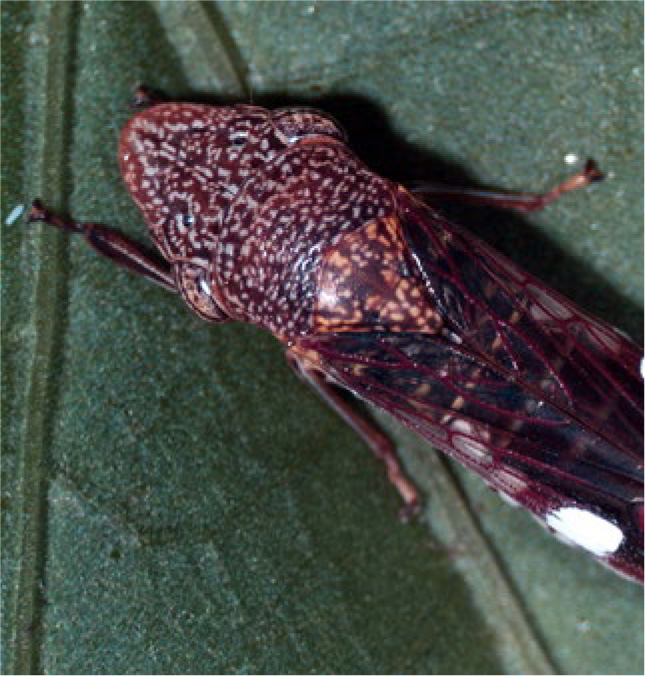
The Glassy-Winged Sharpshooter is a plant-eating true bug which can cause significant crop damage—biological pest control is used against it in French Polynesia.

Hoverflies are pollinators in their adult form—but as larvae, some species prey on leaf-eating insects, making them valuable to gardeners.

A whitefly pupa: These insects are serious greenhouse pests—biological control against them has been used for more than 100 years.
record-breakers
Although every insect species has its own impressive qualities, a few have earned themselves a place in the record books for traits or abilities that set them apart from all the rest.
Insects stand out among other animals in many ways. They are the most abundant, so arguably the most successful of animal groups. They are the only flying invertebrates and the only animal group to show advanced eusociality.
In terms of record-breaking individual species, the heaviest insect is the Little Barrier Island Giant Weta (Deinacrida heteracantha), which can weigh 2½ ounces (75g). The longest-bodied is the extremely spindly stick insect Phryganistria chinensis, which can reach more than 24 inches (62cm) in length. The Hercules Beetle (Dynastes hercules) is the longest-bodied beetle at up to 6⅔ inches (17.5cm), with more than half of that length made up of its enormously long thoracic “horn.” The smallest insects are male wasps of the family Mymaridae, which can be just 0.14mm long.
The White Witch Moth (Thysania agrippina) has the broadest wingspan of any insect—up to 12 inches (30cm)—but its wings are relatively narrow, and in terms of wing surface area it is beaten by other moths, including the Atlas Moth (Attacus atlas).
As we have seen elsewhere, the fastest-flying insects are the dragonflies, with large hawk moths hot on their heels, while the fastest runner is the Australian tiger beetle Cicindela hudsoni, and whirligig beetles (family Gyrinidae) are the fastest swimmers. The Common Froghopper (Philaenus spumarius) holds the high jump record, leaping upward more than 27 inches (70cm). In terms of distances traveled, some individuals of the Globe Skimmer Dragonfly (Pantala flavescens) are known to travel as far as 3,730 miles (6,000km) on their migratory journeys.
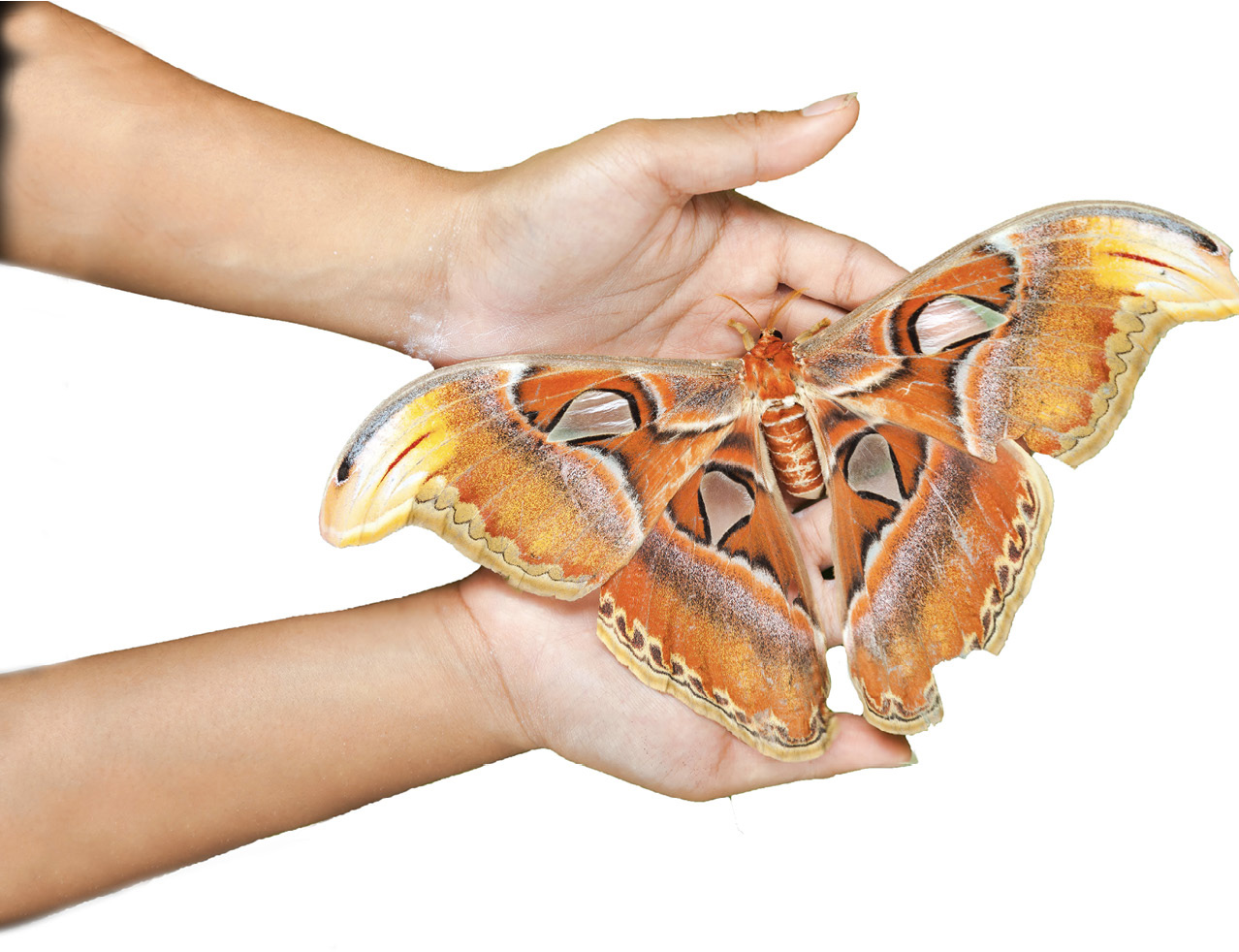
The Atlas Moth’s wing surface area can be up to 62 square inches (400cm2).

A White Witch Moth is inconspicuous when resting, despite its tremendous 12-inch (30cm) wingspan.

The Hercules Beetle can measure 6⅖ inches (17.5cm) from the tip of its horn to the tip of its abdomen.
The loudest insect is the African cicada Brevisana brevis, males of which chirp at 110 decibels. The insect with the brightest bioluminescence is the Headlight Elator Beetle (Pyrophorus noctilucus)—like other bioluminescent animals, it produces its light (from a pair of “headlights” on its thorax) through the action of the enzyme luciferase on the light-emitting pigment luciferin.
exceptional ants
There are somewhere between 10 trillion and 10,000 trillion ants alive on Earth today, making them the most abundant insect group in terms of numbers of individuals. Their total biomass is about the same as Earth’s human biomass. Some ant species form nests of extraordinary size. A colony of Japanese Red Wood Ants (Formica japonica) on the island of Hokkaido, Japan, was formed from 45 individual but interconnected nests, and is estimated to hold about 1.1 million queens and 306 million workers. A colony of non-native Argentine Ants (Linepithema humile) in Melbourne, Australia, is about 60 miles (100km) across.
threats facing insects
Insects, like all organisms, face a range of threats to their survival. Their populations are so fundamental to ecosystems that their loss often impacts negatively on many other species.
Earth is a dynamic system, and over its long history many natural events have occurred that have devastated animal populations, on local and global scales. Over the last century, though, most of the serious threats facing insects have come about as a result of human activity.
The greatest single threat is habitat loss and damage. Wild habitats are under constant and increasing pressure from an encroaching human population. They may be directly replaced wholesale, by farmland, plantations, or urban development, or may suffer indirectly, through desertification, pollution, or fragmentation. For an insect population, even a small road built through the area they occupy may be an insurmountable barrier, and when populations become broken up they are more susceptible to the problems of inbreeding (reduced genetic diversity, making genetic problems more likely to occur).
Some insect species can do tremendous damage to our crops, and this problem is often tackled with pesticides. However, traditional pesticides such as DDT kill all insects, and their widespread use across western Europe and North America in the 1960s and 1970s resulted in devastating crashes, not just in insect populations.

The Yellow Crazy Ant has had a serious impact on the biodiversity of several islands where it has been accidentally introduced.
Our unfortunate habit of introducing non-native species to countries far from their origin has also had a severe impact on many insect species. This problem is worst on islands where a restricted fauna has evolved, often in the absence of any higher predators. Adding a generalist predator (one that evolved within a much more diverse and mixed fauna) to such an environment often spells disaster for the native species. For example, in New Zealand (a country that, historically, had no native predatory mammals) several of the 70 weta species are threatened by introduced rats, stoats, cats, and hedgehogs. Weta are large, slow-moving relatives of the grasshoppers—they evolved alongside insectivorous birds, but are ill-equipped to defend themselves against these mammalian predators.
Collecting insect specimens for museums is not generally too harmful if carried out responsibly, but species that are already very rare may be threatened with total extinction by unscrupulous collectors, eager to secure a specimen before it is too late.
insects as threats to other species
Invasive, non-native species threaten wildlife and ecosystems in many parts of the world, and several damaging invasive species are insects. One of the most notorious is the Yellow Crazy Ant (Anoplolepis gracilipes), probably native to East Africa but now present on many island groups. It is highly predatory, aggressive, and forms vast super-colonies. Its impact on the Christmas Island fauna has been devastating.

The beauty of New Zealand’s landscape belies the extent of the ecological damage brought about by an array of non-native species.
extinction
The vast majority of all species that have ever evolved have become extinct, and this fate awaits the rest—even ourselves. However, today the extinction rate is far higher than is “natural.”
When the last individual of a species dies, that species has become extinct and cannot ever return (at least, not until cloning technology is improved). If the species survives only in captivity it is classed as extinct in the wild, but if the remaining individuals (whether in the wild or in captivity) cannot generate a viable breeding population (if numbers are too low, for example, or if all remaining individuals are of the same sex), that species is considered to be functionally extinct.
Of course, many (perhaps most) extinctions go unobserved by human eyes—and there is no doubt that among those were countless species that were never even “discovered,” especially when it comes to insects as so many are small, difficult to observe, and hard to identify.
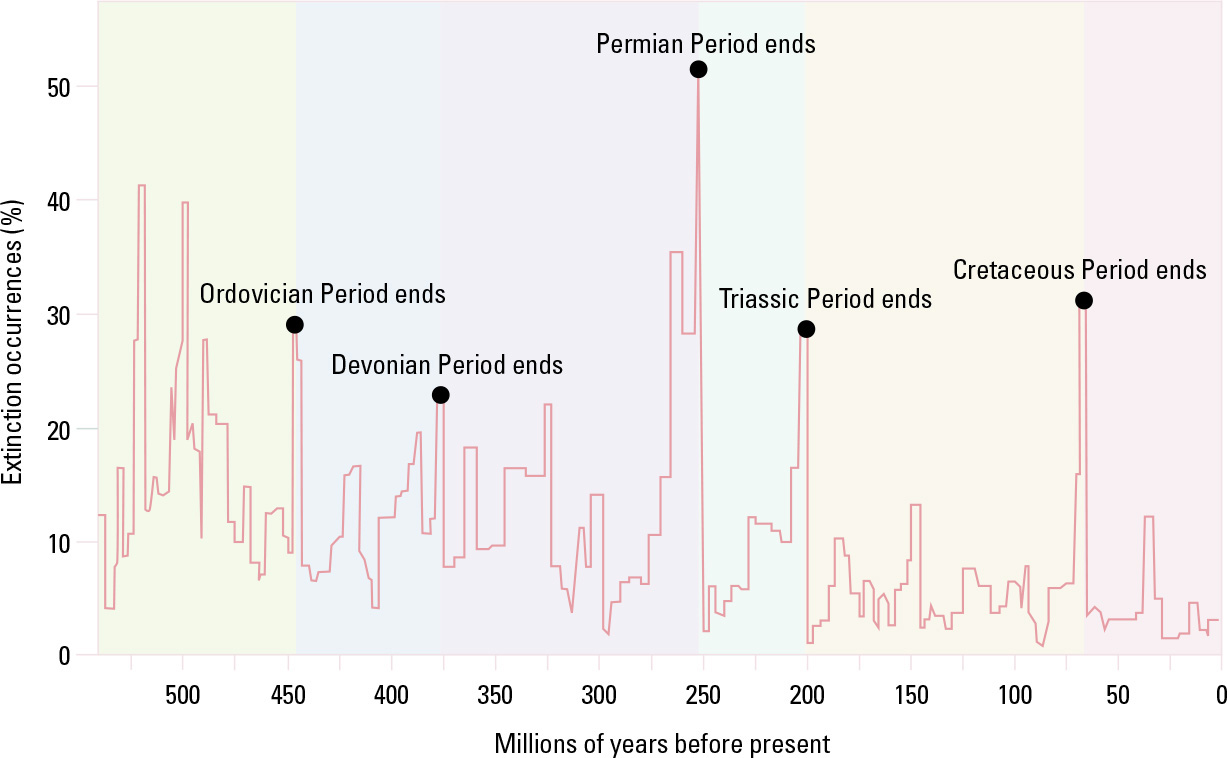
The fossil record shows us that the general extinction rate has fluctuated considerably over the last 500 million years, but five conspicuous spikes indicate rapid mass extinction events.
Confirming extinction in the wild is always somewhat uncertain, and there are many examples of rediscovery of presumed-extinct species. But, in general, if repeated field surveys of all known sites for an endangered species turn up no sightings over several seasons, then that species is likely to have become extinct. Recently extinct insects include the Xerces Blue (Glaucopsyche xerces), a North American butterfly last seen in 1943, a victim of urban development of San Francisco in its sand dune habitat. This species gave its name to the conservation group the Xerces Society, established in 1971 and committed to protecting populations of invertebrates considered essential to biodiversity and ecosystem health.
Other recently extinct insects include Megalagrion jugorum, a spectacularly long-bodied damselfly from the Hawaiian island of Maui, the once extraordinarily abundant Rocky Mountain Locust (Melanoplus spretus) of North America, whose swarms could include more than 10 trillion individuals, and the Saint Helena Earwig (Labidura loveridgei), an enormous earwig endemic to Saint Helena island in the South Atlantic, which was wiped out in the 1960s by introduced rodents and predatory invertebrates.
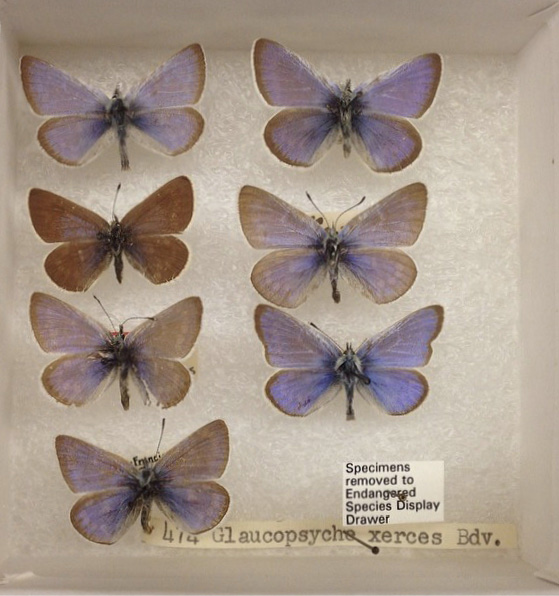
The only way to see the lovely Xerces Blue butterfly today is in a museum cabinet.
return from oblivion
Cloning offers a real chance of restoring an extinct species to the world. The technique would involve extracting a cell nucleus (complete with a full set of DNA) taken from preserved specimens of the extinct species, and placing it inside an egg cell of a very similar host species. The result would be a new living animal that was a genetic “twin” of the specimen from which the cell nucleus was taken. The first successful cloning of an insect took place in 2004 using fruit flies (Drosophila), but the technique has not yet been used to try to recreate an extinct species.
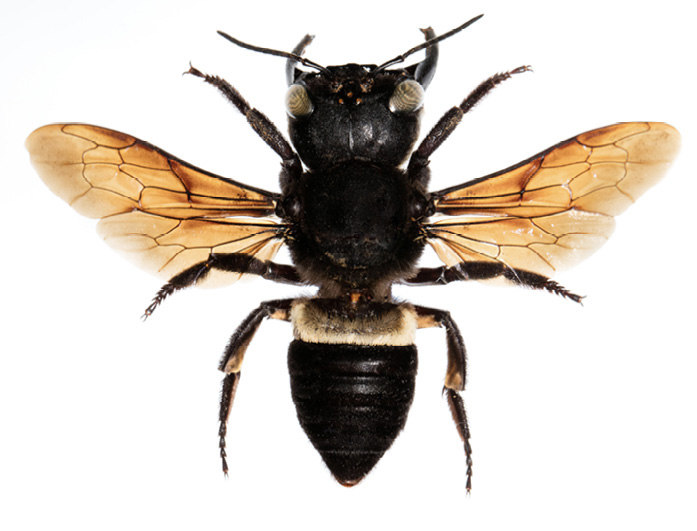
Wallace’s Giant Bee, an Indonesian species and the world’s largest known bee, was presumed extinct after no sightings in the wild since 1981, but it was rediscovered in 2019.
ENDANGERED INSECTS
Sadly, many animal species around the world are in danger of extinction. This includes a large number of insects, though their plight is little known compared to larger and more familiar animals.

Habitat damage and loss harms entire ecosystems, and recovery is a long, slow process.
Wildlife today faces a relentless array of threats, the majority of them caused by human activity. It is no exaggeration to say that a sixth mass extinction is underway, which could prove no less devastating than the last (when the aftermath of a huge asteroid strike destroyed some three-quarters of all plant and animal species on Earth, some 66 million years ago).
Threatened and endangered species
More than a million insects have so far been described by science, and there are likely to be at least five million more that have not yet been discovered. The International Union for Conservation of Nature (IUCN) has so far assessed a tiny proportion of them—nearly 4,300 species. Almost a quarter of those have been found to be at risk of extinction, and there is no reason to suppose that the proportion will change as more species are described and more assessments are completed.

The International Union for Conservation of Nature (IUCN) is a global organization that assesses how close each wild species is to extinction, based on all available evidence. The categories it uses are Least Concern (no immediate risk of extinction) through Near Threatened, Vulnerable, Endangered, Critically Endangered, Extinct in the Wild, and Extinct. Species for which insufficient data exists are classed as Data Deficient. At the time of writing, nearly 4,300 species have been fully assessed, of which about 1,150 are placed in one of the threatened categories.
About 200 insect species are classed as Critically Endangered, meaning they are considered to face an extremely high risk of extinction in the wild. Among them are such beautifully named species as the Merry Shadowdamsel Damselfly (Drepanosticta hilaris), the Natterer’s Longwing Butterfly (Heliconius nattereri), and the Canterbury Knobbled Weevil (Hadramphus tuberculatus)—but most have no common name and probably never will.
The true picture?
A further 1,700 insect species are classed as Data Deficient, and a proportion of these are undoubtedly in severe danger, too—and then there are unknown numbers of species that have yet to be discovered and described. Many of those will surely die out without ever being known to us.
The rate of species loss around the world today is estimated to be about 1,000 times higher than the natural “background rate.” The current mass extinction is occurring across all taxonomic groups, all parts of the world, and in all kinds of habitats, but is especially marked in the most biodiverse parts of the world. Because of insects’ ecological importance, their loss has an impact on many other species, from plants to the largest alpha predators.

Heliconious butterflies from Atlantic forests in Brazil: Documenting the insect fauna of fast-changing habitats is a race against time.
The trickle-down effect of insect extinctions and declines is only too apparent when we look at other animal groups. In North America, for example, there are 2.9 billion fewer birds than there were in 1970 (a decline of 29 percent), and insect-eating species have been disproportionately affected. As we will see here, insect population declines worldwide are also very concerning for humankind.
insect conservation
As the 21st century progresses, we are becoming increasingly aware of the wholesale disappearance of wildlife from our planet. Insect biodiversity is plummeting, and this impacts all other living things.
The history of conservation is full of individual success stories, including some that concern insects. One of the best known is that of the Lord Island Stick Insect (Dryococelus australis), native to the Lord Howe Island group near New Zealand. This stout phasmid was extinct on Lord Howe Island by 1920, thanks to introduced rats, but in 2001 was found to still survive on a nearby rat-free islet. Two pairs were brought to Melbourne Zoo, and a captive breeding program was begun while Lord Howe Island’s rats were eradicated. Today, several thousand of the insects have been bred in captivity.
Captive breeding and reintroduction is often successful for restoring populations of particular insects, as long as the factors that caused them to decline in the first place are addressed. In the UK, the Large Blue Butterfly (Phengaris arion) has been reestablished from mainland European stock after its disappearance from the UK in 1979, but this project was only possible after biologists had studied the butterfly’s ecology and identified the crucial role played by a species of red ant, Myrmica sabuleti, in a unique parasitic relationship. Sites for the reintroduction were managed for some years in order to boost ant populations before any of the butterflies were released.

A “bug hotel” like this in your garden will provide nesting and hibernation places for a wide range of invertebrates.
Saving a single, very rare, or range-restricted species from extinction is a worthwhile effort, but in terms of overall ecological impact, just a footnote to the story. It is the general declines, including declines among very abundant species on which many other species depend, that are so damaging to ecosystems as a whole. A 2017 report from Germany, studying data from 63 nature reserves, stated that midsummer insect abundance had fallen by 82 percent between 1989 and 2016. A similar report from the El Yunque National Forest in Puerto Rico reported a loss of 78 to 98 percent in ground and tree canopy arthropods between 1976 and 2012—these losses are largely attributable to climate change.
Declines on this scale should and do alarm us, not least because a large proportion of the crops we grow depend upon insect pollinators. Other land species are already being affected by the losses—the wild plants that depend on insects to pollinate them, and the animals that feed on insects. Conservation now has to be on a global scale if we are to avert the unfolding crisis.
starting at home
One of the advantages that insects have is (in most cases) a fast reproductive rate. This means that their numbers can recover dramatically over just a few generations, if conditions improve for them. It is easy to encourage insects to thrive within the little fragments of open space that are our own. Plant your garden with native species, stop using pesticides, and add other natural habitats (perhaps a wildflower meadow, a pond, or a woodpile) to make your own contribution to boosting your local insect fauna. Most countries have at least one charitable conservation body that works to protect insects and their habitats. Joining organizations like these will help support their work and keep you informed about local and national issues affecting insects and other wildlife.

Tropical forest is the most biodiverse land habitat on Earth.

A reintroduction project brought the Large Blue Butterfly back to England in the 1980s.